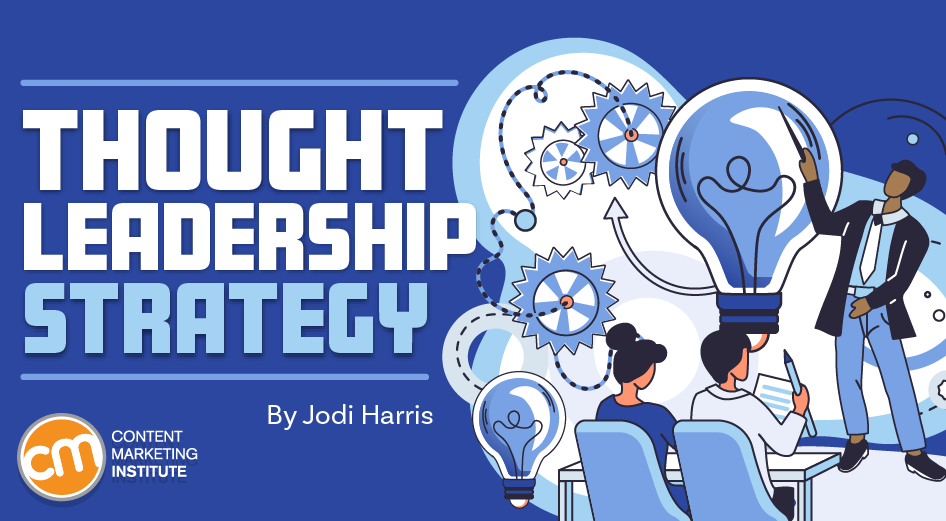
Many enterprises never built the all-important bridge between content marketing and sales operations.
Almost two-thirds (64%) of enterprise marketers say they struggle to communicate across business functions, according to the 2023 Enterprise Marketing: Benchmarks, Budgets and Trends research.
One clear sign your organization belongs in that group? Sales reaches out to you for new thought leadership content for their next lead-generation campaign, but they don’t share how that content performs or involve your team in ongoing initiatives.
Limited collaborations like these can fuel top-funnel goals but contribute little to the bigger brand picture. They don’t help sales nurture initial leads into customers. They force content creators to work as an assembly line, filling content buckets at the expense of developing fresh ideas and multipurpose storytelling.
Top-of-the-funnel #ThoughtLeadership content does little to help the sales team nurture initial leads into customers, says @Joderama via @CMIContent. Click To Tweet
To expand your thought leadership collaborations, rethink your strategy and reimagine how it can help fuel every stage of the customer journey. In a recent webinar on enterprise marketing (registration required), ON24’s Mark Bornstein and CMI’s Robert Rose discuss what those changes might look like and how to get started. Here are some ideas they shared, along with some examples, to guide your efforts:
1. Refresh your thought leadership approach
Robert says many B2B organizations view sales’ role in content as a distribution channel – using the latest thought leadership to generate leads. Given buyers seek educational content long before they ever connect with sales, that sounds like a good strategy.
But here’s the problem: Every one of your competitors does the same thing.
That forces consumers to sift through all the available information to find the answers they need. It also does little to distinguish your content from your competitors’ – a challenge faced by 37% of enterprise marketers, according to CMI research.
“Buyers have zero interest in becoming subject matter experts,” Robert says. “How do [you] start creating content that actually is different and helpful?”
Buyers don’t seek #content so they can become subject matter experts. They want helpful #content, says @Robert_Rose via @Joderama @CMIContent. Click To Tweet
The answer lies not in empowering consumers but in empowering your sales team with better stories to tell. Robert says that should involve supplying sales with thought leadership content that supports customer goals across the journey. Create stories that progress from why the prospect should change to how the prospect should change and, ultimately, how you can help them change.
TD Bank Group exemplifies this concept in its TD Stories. This content hub’s mission is to build stronger customer relationships by demonstrating how TD can add value to their lives, according to its 2022 Content Marketing Awards submission. (TD Stories won Best Content Marketing Program in Financial Services.)
TD Stories hosts a slate of multimedia offerings that provide expert thought leadership on a range of financial topics. That content includes updates on TD Bank Group’s technological advances and community involvement, as well as recommended approaches consumers can follow to better manage their finances.
For example, in a recent TD Stories article about credit cards, the brand highlights the benefits some customers might not know and explains how to use them to optimize their spending power. It is grouped in the Your Money section. Other categories include innovation, colleagues, community, insights, and news.

2. Stop conflating content and containers
Content teams that function as internal order takers have little say in how other teams in the business should use the content. However, you can shift how you execute and package those factory-like content creations to serve more than the original requested purpose.
“I’ve seen so many great, big, wonderful thought leadership ideas trapped in the context of a blog post because that’s what was requested first,” Robert says.
Instead, to prevent big ideas from getting stuck, discuss ideas first, then work out the most appropriate containers. Breaking out of format-centric thinking also allows the brand to extend the value of its content assets by repackaging the big ideas in multiple formats or in pursuit of additional brand goals.
Marketing company Epsilon created its Personalive event to empower and inspire the world of personalized marketing, as it explains in its Content Marketing Awards entry. It took the content from the event and transformed it into an online resource center, repurposed its demos into how-to blog posts, and used the assets for a multi-touch demand generation initiative and other vertical campaigns. (Personalive won top honors for Best In-Person or Virtual Event.)
3. Expand the potential of your chosen channels
ON24’s Mark Bornstein says marketers also can benefit from expanding their vision beyond traditional formats you favor for telling certain stories but not others.
For example, though 77% of enterprise marketers create webinars, virtual events, or online courses, too many stop there. They don’t tap into the full storytelling potential of this channel. That should change.
“We’re seeing the event technologies being used in new and creative ways. Whether it’s a talk show, a discussion forum, or a community event … They’re all experiences, and they can be any kind of experience you want,” Mark says.
Too many enterprise marketers create webinars or virtual events without tapping into the full storytelling potential of the channel, says @4markb via @Joderama @CMIContent. Click To Tweet
Just as content marketers should expand their thinking in repurposing content and rethinking formats, they also should rethink how they define their role in the organization.
“You need to start thinking of the content marketing team as producers and programmers of ideas,” Mark says.
4. Program inviting spaces for conversation and collaboration
Fifty-three percent of enterprise marketers say their organization plans to invest in social media/community building in 2023 – that’s a 64% jump from those who said the same about 2022.
Robert and Mark contend marketers can achieve that goal by leaning into owned media experiences as opposed to social media experiences. They recommend building spaces where consumers can gather, connect, and have conversations, even those that fall outside your brand’s core expertise.
How can marketers go about building a community-centric conversation space? Mark points to one of his clients: “They’re building a serialized program where they talk about things that matter to health care providers specializing in a specific care area. They’re not talking about their products at all. They’re just creating a place to gather for those conversations.” Mark says.
Salesforce’s Tableau community also puts this concept into play. It has educational resources like blogs and configurator tools, as well as virtual events and advice forums. Programming includes My Tableau Story, which features a rotating schedule of live and on-demand sessions with community experts who can answer members’ questions.
Members can participate in community projects, where they get a chance to show off their creative skills, passions, and areas of expertise. They also can enter challenges and create for fellow community members. One member created this playing card-inspired interactive graphic created for Tableau’s #B2VB visualization challenge. Click on a card to reveal an affordable activity to try when traveling to Las Vegas.

A community-centric thought leadership approach can be invaluable for generating vital first-party data. The more an experience enables consumers to choose and interact, the more first-party data the brand will receive about the audience.
“That first-party data is how we help salespeople; it’s how we build relationships, learn about people further, and personalize that journey to serve the next right piece of content better. That’s an important part of the story,” Mark says.
Better thought leadership makes your business better
Expanding your definition of thought leadership content can give your marketing team fresh opportunities to distinguish your brand’s value and drive stronger relationships with customers. It can also help you develop stronger, more impactful partnerships with other functional teams in your organization. Give these ideas a try, and share your thoughts in the comments.
HANDPICKED RELATED CONTENT:
Cover image by Joseph Kalinowski/Content Marketing Institute

![HubSpot's 2025 State of Blogging Report [Data from 500+ Marketers]](https://www.liveseo.com/wp-content/uploads/2025/02/HubSpots-2025-State-of-Blogging-Report-Data-from-500-Marketers.webp-300x300.webp)


